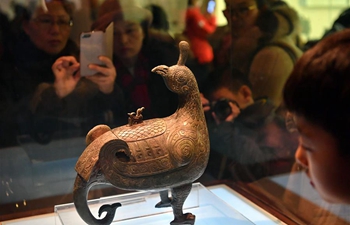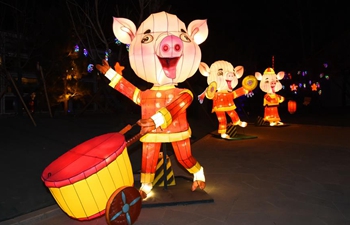BUENOS AIRES, Feb. 9 (Xinhua) -- Argentina, a meat-lover's paradise famed for its beef barbecues, has set its sights on an alternative source of protein: crickets.
Unlike Mexico, where diners often spend big bucks on well-seasoned grasshoppers, Argentina doesn't have a tradition of eating insects, so studying crickets for human consumption is a radical idea in this South American country.
Researchers at the National Institute of Industrial Technology (INTI) now "seek non-conventional new sources of protein," said Gabriela Gallardo, a professor of chemistry and food microbiology at the University of Buenos Aires.
"Eating protein is very important for humans, especially if the protein has essential amino acids and if the protein's nutritional quality is good," Gallardo told Xinhua at INTI's laboratory in northwest Buenos Aires. "And that's the case with insects."
"That's why globally there is a search for these new sources of protein and insects are playing a very important role in this area," she added.
Gallardo, who heads INTI's research and development in food, specifically new ingredients, indicated that eating insects may not be as unusual as it seems, with different countries having legislation regulating what types of "insects can be consumed."
Argentina's food laws don't include crickets, at least not yet.
"We are studying its protein quality," she said, adding that the data shows "its nutritional quality is very good," with a fairly high percentage of essential amino acids.
Researchers are currently pursuing two basic objectives as their two main lines of research, according to Gallardo.
The first is "using cricket meal, in other words, drying and grinding crickets to obtain meal, then mixing it with a traditional flour, like wheat flour, and seeing how it performs when making a baked product," said Gallardo.
The second is to isolate the proteins that are "of such high nutritional value" to obtain isolated or concentrated proteins for sports drinks or dietary supplements, she said.
The researchers have already presented a wheat flour mix with 10 percent cricket meal at international and national scientific congresses.
"Our results were very positive, as they served for a wide variety of baked goods," said Gallardo.
Sourcing protein from crickets, as opposed to cows, has notable environmental benefits, according to biologist Daniel Caporaletti, who supplies the team with the crickets they need.
Unlike bovines, crickets "consume very little water and emit no methane, at least the native ones don't," he said.
"Traditional cattle-ranching emits 18 percent of the (world's) greenhouse gases through methane and through respiration," said Caporaletti. "In addition, it consumes 30 percent of the world's drinking water."
"It takes 10 kilos of balanced feed to obtain one kilo of beef, three kilos of pork or five kilos of poultry," he said.
With those same 10 kilos, "you can obtain nine kilos of insects, because insects don't thermoregulate," or regulate their body temperature, he explained.
"Mammals and birds thermoregulate, they invest a lot of the energy we give them in maintaining their internal temperature," said Caporaletti. "With insects, everything they consume goes into growth."
Traditional animal farming also produces a great deal of fecal waste that pollutes land and water sources, he said.
Crickets "are a high quality animal protein ... that rival beef or chicken," said the biologist.

















